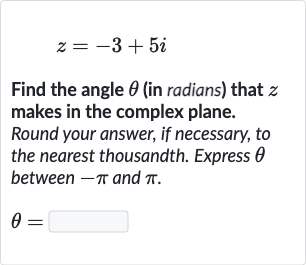Full solution
Q. Find the angle (in radians) that makes in the complex plane. Round your answer, if necessary, to the nearest thousandth. Express between and .
- Calculate Argument: To find the angle that the complex number makes with the positive real axis in the complex plane, we need to calculate the argument of the complex number. The argument is the angle in polar coordinates and can be found using the function, which gives the angle whose tangent is the quotient of the imaginary part over the real part of the complex number.
- Find Tangent Ratio: The complex number has a real part of and an imaginary part of . The tangent of the angle is the ratio of the imaginary part to the real part, which is . Therefore, we use the function to find the angle: .
- Adjust for Quadrant: However, since the real part of is negative and the imaginary part is positive, lies in the second quadrant of the complex plane. The range of the function is , but we need to adjust the angle because the function does not account for the quadrant in which the complex number lies. To find the correct angle in the second quadrant, we add to the value.
- Calculate Arctan Value: Calculating the arctan value: . Using a calculator, we find that radians. Since this is in the fourth quadrant and we need the angle in the second quadrant, we add to get the correct angle: .
- Add Pi: Adding to radians, we get radians. Since we want the angle to be expressed between and , and radians is within this range, this is our final answer.

